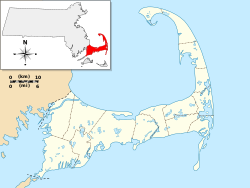Chatham Windmill | |
 | |
| Location | Chase Park, Chatham, Massachusetts |
|---|---|
| Coordinates | 41°40′34″N69°57′33″W / 41.67611°N 69.95917°W |
| Area | less than one acre |
| Built | 1797 |
| Architect | Benjamin Godfrey |
| NRHP reference No. | 78000421 [1] |
| Added to NRHP | November 30, 1978 |
The Chatham Windmill is a historic windmill at Chase Park in Chatham, Massachusetts. Built in 1797, it is one of the state's few surviving wooden windmills, and also one of the few still in working condition. The windmill was listed on the National Register of Historic Places in 1978. [1]



